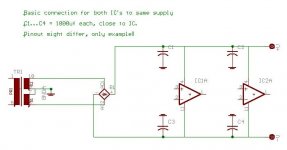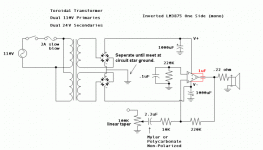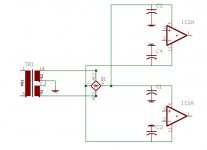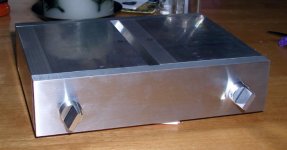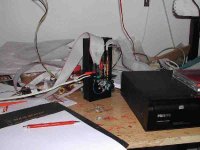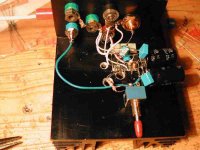"Hit me with your rythm' stick"
Dear fellows
I had claimed that i spotted dramatic differencies in sound due to resistors directionality ("This is not just another gainclone" thread, page 47, post# 698). Suggestions for repeated and reversing testing from Bobken, open doupt from MRehorst, and my own uneasiness with the subject findings, pushed me into more testing. I used various setups (one LM1875, later two LM7815 amps and special connectors for attaching the resistors), but as the testings were progressing, it became clear to me that-as Bobken and Fedde have also marked- the important think is to isolate one variance from the others. So finally, i settled for a single, fixed, compact "jury rig". A TDA7294 (more detailed sound compared to LM1875), inverted [Rin=12K, Rfb=120k,Vin+ tied to grnd. stabilised +/-15VDC, 1000uF//0.1uFper polarity], mounted on a big heatshink with all the connections to the outside world firmly attached to an aluminum angle bolted to the heatshink. No loose connections or moving cabling anymore. I started probing the feedback resistor first. I was soldering and desoldering it directly on the applicable IC pins, with listening tests in-between. Soon I found out that my listening memory is short termed, at least as some very critical details are concerned, so i had to shorten the time (approx.3 minutes) between testings. I opted for a DPDT switch for to switch btn two resistors in the feedback path. Now, time between testing was approx 3 seconds. I was more confident for my judgement now. The following resistors were under (sighted) test:
1. Single 120K 1/4W carbon film 5% resistor (two pieces, A and B).
2. Single 120K 1/2W carbon film 5% resistor (two pieces, A and B).
3. Single 120K 1/2W metal film 2% resistor (two pieces, A and B).
The test patern was as follows:
ll Test No ll Resistor in Switch Position x ll Resistor in Switch Position xx ll
ll a. ll 1A ll 1B in opposite direction of 1A ll
ll b. ll 2A ll 2B in opposite direction of 2A ll
ll c. ll 3A ll 3B in opposite direction of 3A ll
Each of the above abc tests was intended to discriminate the directional effects (if any) for each resistor type. Listening material was intentionally limited to 3 minutes sections of 2 particular musical pieces. List: Piano Concerto No1 (Boris Berezovsky, Philarmonia Orcestra, Hugh Wolff, 1995 Teldec DDD recording), and Korngold: Concerto for Violin and Orchestra in D major (Gil Shaham, London Symphony Orchestra, Andre Previn, 1994 Deutche Gramm. DDD).
Each test was comprised of 20 comparisons (switch position changes), 10 for List and 10 for Korngold.
The results did not confirm my previous claims, at least they did NOT support any dramatic directional effects. This is all that i can expect for such a test. It left me with a marginal preference for a particular direction -the same for all three resistor types-but generalisation and confirmation requires blind tests and a great number of resistors, sampled randomly from many sources at different times ect, ect.
This test gave me the chance to compare the "sound" of the three resistor types. I can say that for the particular setup, the 1/4W carbon was the least discriminating. The 1/2W metal, seems to be the most detailed. The 1/2W carbon gives the impression of having more "body", not much away from the 1/2W metal in terms of clarity.
I tried some more tests with long listening intervals and different music material, the results of which, didn't contradict the above claims.
Then i conducted some more tests:
Single 120K 1/4W carbon film 5% resistor, direction x, against
two 240K 1/4W carbon film 5% resistors in parallel, direction x. The parallel combination seems to give marginally more detailed sound. This, may be due to power sharing (douptfull, as voltage drop across resistors was approx. 3mVpp), or due to partial randomisation of the resistors properties.
Two 240K 1/4W carbon film 5% resistors in parallel, direction x,against
two 240K 1/4W carbon film 5% resistors antiparallel. No difference perceived.
These two last groups of tests (conducted following the protocol of the initial tests) were repeated for the carbon 1/2W and for the metal 1/2W. Same results, no difference.
Such tests (as Steve Eddy has pointed out) can not be scientific. Even under the most strickt protocols, the only think they guarantee is that they minimise the influence of SOME variables. The conclusions are applicable to the particular setup only.
The only reason i presented them here is that i felt it as an obligation, since i have made such a claim of resistors directivity in the past. I appologise for the fuzz. The details are given for the record, and for repeatability purposes. The (due to methodology) limited conclusions are totally biased by my hearing ability, and the quality of my audio chain. This means that differencies may exist, but i am not able to detect them. In any case though, the application of two antiparallel resistors in place of a single resistor, may wipe out any real or imaginary "directivity coloration".
The whole thing took me about 50 hours. What did i gain from this ?
1. Peace of mind. I don't have to check all the resistors of my equipments. Even if differencies may exist, they are not dramatic. This is enough for me.
2. A reliable setup, which i can use in the future to A-B test other components.
3. A limited A-B testing experience.
Regards
George
Dear fellows
I had claimed that i spotted dramatic differencies in sound due to resistors directionality ("This is not just another gainclone" thread, page 47, post# 698). Suggestions for repeated and reversing testing from Bobken, open doupt from MRehorst, and my own uneasiness with the subject findings, pushed me into more testing. I used various setups (one LM1875, later two LM7815 amps and special connectors for attaching the resistors), but as the testings were progressing, it became clear to me that-as Bobken and Fedde have also marked- the important think is to isolate one variance from the others. So finally, i settled for a single, fixed, compact "jury rig". A TDA7294 (more detailed sound compared to LM1875), inverted [Rin=12K, Rfb=120k,Vin+ tied to grnd. stabilised +/-15VDC, 1000uF//0.1uFper polarity], mounted on a big heatshink with all the connections to the outside world firmly attached to an aluminum angle bolted to the heatshink. No loose connections or moving cabling anymore. I started probing the feedback resistor first. I was soldering and desoldering it directly on the applicable IC pins, with listening tests in-between. Soon I found out that my listening memory is short termed, at least as some very critical details are concerned, so i had to shorten the time (approx.3 minutes) between testings. I opted for a DPDT switch for to switch btn two resistors in the feedback path. Now, time between testing was approx 3 seconds. I was more confident for my judgement now. The following resistors were under (sighted) test:
1. Single 120K 1/4W carbon film 5% resistor (two pieces, A and B).
2. Single 120K 1/2W carbon film 5% resistor (two pieces, A and B).
3. Single 120K 1/2W metal film 2% resistor (two pieces, A and B).
The test patern was as follows:
ll Test No ll Resistor in Switch Position x ll Resistor in Switch Position xx ll
ll a. ll 1A ll 1B in opposite direction of 1A ll
ll b. ll 2A ll 2B in opposite direction of 2A ll
ll c. ll 3A ll 3B in opposite direction of 3A ll
Each of the above abc tests was intended to discriminate the directional effects (if any) for each resistor type. Listening material was intentionally limited to 3 minutes sections of 2 particular musical pieces. List: Piano Concerto No1 (Boris Berezovsky, Philarmonia Orcestra, Hugh Wolff, 1995 Teldec DDD recording), and Korngold: Concerto for Violin and Orchestra in D major (Gil Shaham, London Symphony Orchestra, Andre Previn, 1994 Deutche Gramm. DDD).
Each test was comprised of 20 comparisons (switch position changes), 10 for List and 10 for Korngold.
The results did not confirm my previous claims, at least they did NOT support any dramatic directional effects. This is all that i can expect for such a test. It left me with a marginal preference for a particular direction -the same for all three resistor types-but generalisation and confirmation requires blind tests and a great number of resistors, sampled randomly from many sources at different times ect, ect.
This test gave me the chance to compare the "sound" of the three resistor types. I can say that for the particular setup, the 1/4W carbon was the least discriminating. The 1/2W metal, seems to be the most detailed. The 1/2W carbon gives the impression of having more "body", not much away from the 1/2W metal in terms of clarity.
I tried some more tests with long listening intervals and different music material, the results of which, didn't contradict the above claims.
Then i conducted some more tests:
Single 120K 1/4W carbon film 5% resistor, direction x, against
two 240K 1/4W carbon film 5% resistors in parallel, direction x. The parallel combination seems to give marginally more detailed sound. This, may be due to power sharing (douptfull, as voltage drop across resistors was approx. 3mVpp), or due to partial randomisation of the resistors properties.
Two 240K 1/4W carbon film 5% resistors in parallel, direction x,against
two 240K 1/4W carbon film 5% resistors antiparallel. No difference perceived.
These two last groups of tests (conducted following the protocol of the initial tests) were repeated for the carbon 1/2W and for the metal 1/2W. Same results, no difference.
Such tests (as Steve Eddy has pointed out) can not be scientific. Even under the most strickt protocols, the only think they guarantee is that they minimise the influence of SOME variables. The conclusions are applicable to the particular setup only.
The only reason i presented them here is that i felt it as an obligation, since i have made such a claim of resistors directivity in the past. I appologise for the fuzz. The details are given for the record, and for repeatability purposes. The (due to methodology) limited conclusions are totally biased by my hearing ability, and the quality of my audio chain. This means that differencies may exist, but i am not able to detect them. In any case though, the application of two antiparallel resistors in place of a single resistor, may wipe out any real or imaginary "directivity coloration".
The whole thing took me about 50 hours. What did i gain from this ?
1. Peace of mind. I don't have to check all the resistors of my equipments. Even if differencies may exist, they are not dramatic. This is enough for me.
2. A reliable setup, which i can use in the future to A-B test other components.
3. A limited A-B testing experience.
Regards
George
Re: "Hit me with your rythm' stick"
Great! And thanks for sharing.
Now if only every 50 hours we spent on something could yield such satisfaction in the end.
se
gpapag said:The whole thing took me about 50 hours. What did i gain from this ?
1. Peace of mind. I don't have to check all the resistors of my equipments. Even if differencies may exist, they are not dramatic. This is enough for me.
2. A reliable setup, which i can use in the future to A-B test other components.
3. A limited A-B testing experience.
Great! And thanks for sharing.
Now if only every 50 hours we spent on something could yield such satisfaction in the end.
se
Hi George,
Thanks for sharing these details with us, and you did quite the right thing in carrying out the detailed tests like you did.
I am not really surprised at your results, as, so far, I have also not detected any directionality in resistors, although the same is not true for many capacitiors which definitely are directional.
I am glad that you are not deterred from trying out similar tests in the future, although this being your first time and the total time taken for testing so long, it must have been rather disheartening.
You have also realised that there is no point in any self-deceit in cases such as these, and that is good lesson to learn if you wish to make some real progress with sonic improvements on your audio equipment in the future.
It is all too easy to convince oneself that because you have spent a lot of time and/or money on a particular modification, that the result must be better regardless, but that is really pointless.
Ironically, several of the most difficult and expensive mods I have tried over the years have been a complete failure, but that is life, as they say, and other easy/cheap mods often unexpectedly make up for these disappointments.
As I said before, not everything that one initially thinks is a real (long-term) change, turns out to be so, but by adopting the suggestions I made, you are as absolutely certain as it is possible to be, and this is what really matters.
If I may offer some more advice for your future testing sessions, in addition to instrumentals, I always listen to vocals too and especially female ones for HF as they can be very revealing if you have some good recordings. Also, male voices cover a surprising proportion of the usual human hearing 'spectrum', and listening to a good tenor like Andrea Bocelli who has wonderful 'colour' in his voice, is always very revealing to me.
Personally, I only attend live concerts a few times each year (and live music is the only real yardstick, as this is what we are trying to replicate, of course) but we all listen to voices every day, and unusual abberations etc. are often easier to pick up this way, simply because we are more familiar with how they should sound.
If it is any consolation to you, when I first started to do these kind of listening tests maybe 30 years ago, my success rate was probably only about 60% (at a guess), but things improved over the succeeding years with practice, and I am sure the same will happen to you. It can be frustrating and may at times appear to be fruitless, but it is very rewarding when you discover some real improvements, and then it all seems worth while.
You have a very nice country, by the way, and I have had many happy holidays in the islands around your mainland.
Regards,
Thanks for sharing these details with us, and you did quite the right thing in carrying out the detailed tests like you did.
I am not really surprised at your results, as, so far, I have also not detected any directionality in resistors, although the same is not true for many capacitiors which definitely are directional.
I am glad that you are not deterred from trying out similar tests in the future, although this being your first time and the total time taken for testing so long, it must have been rather disheartening.
You have also realised that there is no point in any self-deceit in cases such as these, and that is good lesson to learn if you wish to make some real progress with sonic improvements on your audio equipment in the future.
It is all too easy to convince oneself that because you have spent a lot of time and/or money on a particular modification, that the result must be better regardless, but that is really pointless.
Ironically, several of the most difficult and expensive mods I have tried over the years have been a complete failure, but that is life, as they say, and other easy/cheap mods often unexpectedly make up for these disappointments.
As I said before, not everything that one initially thinks is a real (long-term) change, turns out to be so, but by adopting the suggestions I made, you are as absolutely certain as it is possible to be, and this is what really matters.
If I may offer some more advice for your future testing sessions, in addition to instrumentals, I always listen to vocals too and especially female ones for HF as they can be very revealing if you have some good recordings. Also, male voices cover a surprising proportion of the usual human hearing 'spectrum', and listening to a good tenor like Andrea Bocelli who has wonderful 'colour' in his voice, is always very revealing to me.
Personally, I only attend live concerts a few times each year (and live music is the only real yardstick, as this is what we are trying to replicate, of course) but we all listen to voices every day, and unusual abberations etc. are often easier to pick up this way, simply because we are more familiar with how they should sound.
If it is any consolation to you, when I first started to do these kind of listening tests maybe 30 years ago, my success rate was probably only about 60% (at a guess), but things improved over the succeeding years with practice, and I am sure the same will happen to you. It can be frustrating and may at times appear to be fruitless, but it is very rewarding when you discover some real improvements, and then it all seems worth while.
You have a very nice country, by the way, and I have had many happy holidays in the islands around your mainland.

Regards,
Well after reading you guyz talk about your gainclone's. I think I am sold on the idea. But me being a tube guy, I am not very familar with SS stuff. So I have a few questions regarding Peter Daniel's schematic. First off what are the capacitors rated at? 25v or 50v? The 4.7 signal cap? I am also curious if any of you have tried more expenive paper in oils or the new jupiter caps. I am very fond of them in tube gear, but maybe you do not like the tube sound.
Next the power supply is confusing me. So Peter you are using one power transformer (22-0-22 @ 400VA) for both channels, right. But I am not understanding how it is layed out. The secondaries are then led to a bridge rectifer then into a 2000uf cap? What is the rating on the power supply caps?
If you have time can you draw up the power supply for both channels. Help out a beginner in the middle of all this information. Thanks
Next the power supply is confusing me. So Peter you are using one power transformer (22-0-22 @ 400VA) for both channels, right. But I am not understanding how it is layed out. The secondaries are then led to a bridge rectifer then into a 2000uf cap? What is the rating on the power supply caps?
If you have time can you draw up the power supply for both channels. Help out a beginner in the middle of all this information. Thanks
Guiness said:Next the power supply is confusing me. So Peter you are using one power transformer (22-0-22 @ 400VA) for both channels, right. But I am not understanding how it is layed out. The secondaries are then led to a bridge rectifer then into a 2000uf cap? What is the rating on the power supply caps?
Hi Guiness
Here are some more good links on the Gainclone.
http://www.geocities.com/rjm003.geo...dio/diy_gc.html
http://home.student.utwente.nl/f.s....o/thor-amp.html
http://www.euronet.nl/~mgw/diy/amps/uk_geenkloon_1.html
http://www.diyaudio.com/forums/show...p?threadid=9112
http://diyaudio.com/forums/showthread.php?threadid=9270
Here is basic PSU connectio, option 1:
Attachments
grrrrrrrrrr
I have a question for all. What am I doing wrong WRT grounding ... I know that is to open ended.
I have build several p3a's and hummmmmmmmmmmm
I thought I would try something easier and build a couple of gainclones and hummmmmmmmm
The hum only is there when I have a stereo amp with a signal on both channels from the same source. For example from a stereo cd player. There does not have to be and music playing but the cd player must be on. I have also tried my Pre Pro and same thing. It is a perfect 60cycle repeat on my scope.
I have the ground going back to the long leds of the powersupply caps. So it is a star as all ground meet there. I have both amps with it's own starground. They meet back at the transformer.
One channel works great by itself. No hum or noise at all. Only when I connect it through an external source do I get a hum.
Can anyone give me any help. I am getting desprete to make somthing work after all this time (about 4 months) and money (abouit $800 total) invested.
Thanks a lot allll
Ted Polzin
I have a question for all. What am I doing wrong WRT grounding ... I know that is to open ended.
I have build several p3a's and hummmmmmmmmmmm
I thought I would try something easier and build a couple of gainclones and hummmmmmmmm
The hum only is there when I have a stereo amp with a signal on both channels from the same source. For example from a stereo cd player. There does not have to be and music playing but the cd player must be on. I have also tried my Pre Pro and same thing. It is a perfect 60cycle repeat on my scope.
I have the ground going back to the long leds of the powersupply caps. So it is a star as all ground meet there. I have both amps with it's own starground. They meet back at the transformer.
One channel works great by itself. No hum or noise at all. Only when I connect it through an external source do I get a hum.
Can anyone give me any help. I am getting desprete to make somthing work after all this time (about 4 months) and money (abouit $800 total) invested.
Thanks a lot allll
Ted Polzin
Peter Daniel said:
If you use the schematic below: 50k log pot at the input, 4.7BG N coupling cap, standard BG caps for PS filtering (4,000u in total), 400VA toroid (double 22v secondaries) with 8 discreet hexfred diodes (separate bridge per rail, both channels share rails, separate wires from PS to amp, 8 total), no bypas, no filtering in PS. Resistors - Riken 1W for 10K input and 220k, 0.5W Holco for feedback (Holco worked well here, Riken might be good too, but I didn't check it yet). Chassis should be solidly built as well. Check my example here: http://www.diyaudio.com/forums/showthread.php?s=&threadid=9112&perpage=15&pagenumber=35.
If you built the amp with those parts, I can almost guarantee that it will equal or better most other commercial offerings, regardless of price. How's that?
Respect!
Unfortunately, there's a lot you can do wrong in building your amp. (this is also from my own experience
 ). I made so many changes to my equipment in the last months, and the sound changed very much too. Things as grounding, topology, shielding, wiring, soldering etc. are also very important besides component quality, condition & treatment. I hope to update my Thor-amp (and dac!) page soon about some of my findings and new knowledge acquired from this and other forums!
). I made so many changes to my equipment in the last months, and the sound changed very much too. Things as grounding, topology, shielding, wiring, soldering etc. are also very important besides component quality, condition & treatment. I hope to update my Thor-amp (and dac!) page soon about some of my findings and new knowledge acquired from this and other forums!And also the matching with other components is important (especially speakers !)
Enough for meAs to the sound, here's a quote from an e-mail I received recently (not my amp):
The sound keeps getting better, and keeps getting 'meatier' and smoother. You are correct in saying that this is an incredible sounding amp, I am in love with it. It has such a 'grab you' factor, that I really have never heard before, and the soundstage is UNBELIEVABLE.
That's the best I can do for you.
Yeah, soundstaging is good. And the amp is quite addictive IMHO !
Fedde
fedde said:
Respect!
Unfortunately, there's a lot you can do wrong in building your amp. (this is also from my own experience). I made so many changes to my equipment in the last months, and the sound changed very much too. Things as grounding, topology, shielding, wiring, soldering etc. are also very important besides component quality, condition & treatment. I hope to update my Thor-amp (and dac!) page soon about some of my findings and new knowledge acquired from this and other forums!
And also the matching with other components is important (especially speakers !)
Enough for me
Yeah, soundstaging is good. And the amp is quite addictive IMHO !
Fedde
Would this more true for the Gainclone amp then for other DIY amps, say a Pass Zen amp? I guess lots of Pass DIY amps also sound differently, but does the final sound depend more on building quality when we talk about the GC ...? A Pass Zen Amp does have a unique sound which all those DIY Zen amps have, to some extend...or am I wrong?
I can never build an amp like you can or Peter can, cause I am a novice. However I guess I'll be building my amps in higher quality if I am motivated by some statements from DIY'ers and owners who praise a particular circuit. This was what made me build a Pass amp and kept me going. And in the end this motivation made me build a really good sounding amp. This is also what makes me build a GC.
That's why I'm so hungry to hear more statements on GC sound quality in general for this amp, but I know I cannot expect to hear something definate....
But I guess it is a very good sounding amp since you guys use it as your main or secondary amp...
Looking forward to see your webpage updated, Fedde...!
Re: Moving DC Blocking Cap
Peter,
I’d be interested in seeing whether moving the DC blocking capacitor directly to the input would change the sound. It seems to me that a small gain in offset would be worth a try if it does not affect the sonics in discernable ways.
I would try to keep all the components at the input side (4.7 uF cap, pot, and 10 K resistor) as far away as possible from those at the output side, including the 1000 uF bypass capacitors, which carry highly nonlinear currents from the class-B operation. There might not be an entirely satisfactory way to do this while keeping a tight layout, but the idea is to minimize the inductive and capacitive coupling between the output and the input.
I agree with you in leaving out the 220K resistor from the noninverting input. It is too high a resistance to hang at the input node, and it makes the noninverting input more susceptible to undesirable capacitive coupling. The need to keep the impedance low at the input would certainly override the concern for DC offset.
Regards,
James
Peter,
I’d be interested in seeing whether moving the DC blocking capacitor directly to the input would change the sound. It seems to me that a small gain in offset would be worth a try if it does not affect the sonics in discernable ways.
I would try to keep all the components at the input side (4.7 uF cap, pot, and 10 K resistor) as far away as possible from those at the output side, including the 1000 uF bypass capacitors, which carry highly nonlinear currents from the class-B operation. There might not be an entirely satisfactory way to do this while keeping a tight layout, but the idea is to minimize the inductive and capacitive coupling between the output and the input.
I agree with you in leaving out the 220K resistor from the noninverting input. It is too high a resistance to hang at the input node, and it makes the noninverting input more susceptible to undesirable capacitive coupling. The need to keep the impedance low at the input would certainly override the concern for DC offset.
Regards,
James
Originally posted by Steve Eddy
Now if only every 50 hours we spent on something could yield such satisfaction in the end.
Dear Eddy
Well, we both know that there are a few other things that yield satisfaction in the end (might i say that one or two of them request less than 5 minutes from us to spend on ).
Anyway, thank you
Dear BobkenOriginally posted by Bobken
...and the total time taken for testing so long, it must have been rather disheartening.
There were your suggestions i had in my mind when i was in the middle of the trials and i was quite tired, that helped me not to give up.
You have also realised that there is no point in any self-deceit in cases such as these.
In fact, i am quite used to (and aware of the implications of the) the testing methodology and the extraction of any statistically meaningfull result. But there ( in my professional life), there are hard facts to be gathered and analused. The irony is that the main scope of some of these tests that i have to design, implement and analyse, is the influence of the "human factor" (i.e. the variance of the human judgement) on the outcome of a properly designed test. The scientific data show to the direction of (the human, being) a creature capable of achieving very high score, but not always, that is, it is unreliable, or in technical terms, having an output with a very high crest factor. With this in mind, i am quite prepared to face very different opinions from people evaluating the same think. I am also aware of my own vulnerability to "expectations", and other human weaknesses as well.
I always listen to vocals too and especially female ones for HF as they can be very revealing if you have some good recordings. Also, male voices cover a surprising proportion of the usual human hearing 'spectrum'
Yes. The human voice! (It has been written that Beethoven was the first composer that didn't have his mind on the human voice as the main "musical instrument" when he was composing non-Lieder music. (he too surrendered though in the 9th). I use human voice on the long term testings. My opinion is that you have to have time to evaluate something with human voice as a stimulus. And i agree with you that female voice (not my wife's please) is good for HF, and male voice for almost full range balance testing. (On the afforementioned long term testings, there were Brigitte Fassbaender's 1990 and Dietrich Fischer-Dieskau's 1955 interpretations of Schubert's "Winterreise"(i am lucking Hans Hoffer's one. Can you help me find it? Phillips does not release the record anymore).
Three weeks ago Hamburg Symphony orchestra performed here in Athens Mahler's "Des Knaben Wundernhorn"Personally, I only attend live concerts a few times each year (and live music is the only real yardstick
I didn't attend, because the week's pocket money had been spent for GC's x-former, housing, heatshinks. Where did i stick my yardstick to?
You have a very nice country, by the way, and I have had many happy holidays in the islands around your mainland.
Actyally, it is my country that has me. Thanks, anyway. I am always willing to enjoy a beer (or a couple or a triple, or..) with people i have common things to share. Just send me a note.
Having said (written) all these, i realised that Peter Daniel may have been upset for having me filling the space of his thread with so much talking, about non (directly) related to the thread subjects. Peter, i am sorry. I will start another thread in the "everything else" with the tittle "Music and psychoacoustics" where i will host my big mouth, together with my small head. Thanks for the hospitality so far, and congratulations for your active contribution to the spread of Thorsten's inverted GC idea.
Regards
George
gpapag said:
Having said (written) all these, i realised that Peter Daniel may have been upset for having me filling the space of his thread with so much talking, about non (directly) related to the thread subjects. Peter, i am sorry. I will start another thread in the "everything else" with the tittle "Music and psychoacoustics" where i will host my big mouth, together with my small head. Thanks for the hospitality so far, and congratulations for your active contribution to the spread of Thorsten's inverted GC idea.
I'm not upset, because this thread belongs to every member reading it. I could always use my mod privileges and move the parts I don't like to a different thread but the thing is, I like them all.
I'm also considering a prize to the person who most accurately guesses the date and time when 200,000 view will occur.
I'll second that.jam said:If you want good this is good......
Jam

- Status
- This old topic is closed. If you want to reopen this topic, contact a moderator using the "Report Post" button.
- Home
- Amplifiers
- Chip Amps
- This is not just another gainclone
